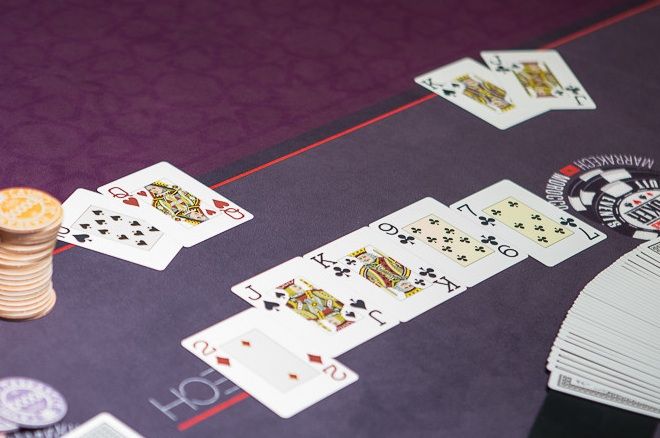How to Determine the Winning Hand in Texas Hold’em

How to Determine the Winning Hand in Texas Hold’em
The first thing players brand new to poker have to learn is how to read the board or five “community cards” in order to determine the winning hand in Texas hold’em. The most important thing to remember is that when making your hand you use the best five cards available among the seven total cards — that is, your two hole cards plus the five cards on the board.
In hold’em you can use any five cards out of the seven to make your hand — in fact, you don’t even have to use the two hole cards which were dealt to you! This is called “playing the board,” and it happens if your best five-card poker hand is the one which is on the board in front of you.
For example, if you get dealt pocket aces and the board is 5♠6♥7♣8♦9♣, your best hand is the nine-high straight on the board in front of you — in other words, your aces don’t even play. In this case, you will chop the pot with your opponent when it comes to showdown unless of course the other player has 10xXx or Jx10x and makes a better straight.
Kicker problems
Another thing to bear in mind is that even with your one-pair hands — where most new players attention only to the pair they have — you need to be aware of the value of your total five-card hand.
For example, say you have A♥5♥ and the board reads A♦7♦4♠10♣2♠. That means your best five-card hand is A-A-10-7-5 — that is, the pair of aces plus the three highest other cards available, the ten, the seven, and the five. In this hand if you put your opponent on a pair of aces as well, the likelihood your A♥5♥ would be best is in fact very slim given that the only other AxXx hand you beat would be Ax3x. That’s because on this board your non-ace card or “kicker” plays.
It is always favorable to have a high card as your kicker when you make a pair, as having a high kicker helps improve the value of your full five-card hand. In the above example, a player holding A♣Q♣ on that A♦7♦4♠10♣2♠ board would have a pair of aces with a queen kicker (A-A-Q-10-7) — a relatively strong hand with which the player could be more confident than with ace-five.
Two-pair hands
One of the most common areas of confusion for new players when it comes to determining who has the winning hand is when both players have two-pair hands.
On a board which reads 10♣9♥4♣4♦5♠, let’s say one player turns over 6♦6♣ while another shows 10♦3♦. I’ve seen new players in this situation who have the sixes mistakenly think their two-pair hand must be best, simply by virtue of the fact that they hold a pocket pair. But they’re wrong.
Let’s go through the five-card analysis again. The best five-card hand for the player with 6♦6♣ is sixes and fours with a ten — 6-6-4-4-10. Meanwhile the player holding 10♦3♦ has tens and fours with a nine — 10-10-4-4-9 — or a higher two-pair hand. This can be very tilting for the player with the pocket pair.
Counterfeiting
Finally, let’s have a look at something called counterfeiting. This doesn’t happen too often, but when it does you need to be aware of it.
Counterfeiting occurs when a community card is dealt that both alters the value of your own hand and increases the chance of an opponent having a better hand than you. It’s a little odd, because what happens is that your hand technically improves while likely making it less strong relative to your opponent’s hand.
For example, on a board of J♠7♦5♣ a player who has 7♥5♥ has a two-pair hand and is ahead of an opponent holding A♣A♥. But if a Jx were to fall on either the turn or river, the player holding pocket aces would improve to a better two-pair hand (aces and jacks) and gain the advantage.
Notice how the player with 7♥5♥ would also improve to a better hand if a jack comes (going from sevens and fives to jacks and sevens) — but unfortunately the card that improved the hand also made it worse than the other player’s hand. Using the terminology of the game, the 7♥5♥ player’s two-pair hand has been “counterfeited” as the pair on the board gave the other player a better two-pair hand.
As in all of these examples, it is very important always to keep track of your best five-card hand. When you’ve done it for long enough, it may even start to seem like second nature recognizing what hands beat what. However, there may still be occasions when you end up staring at the board for a good minute trying to figure out what you have (and at the same time what your opponent might have!) and if you have the winning hand in your Texas hold'em game.
Want to stay atop all the latest in the poker world? If so, make sure to get PokerNews updates on your social media outlets. Follow us on Twitter and find us on both Facebook and Google+!









